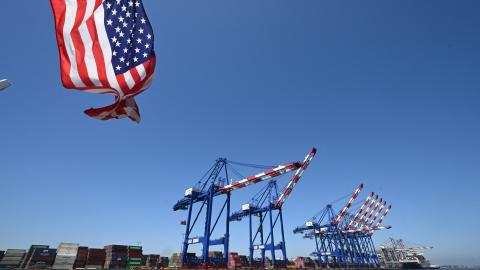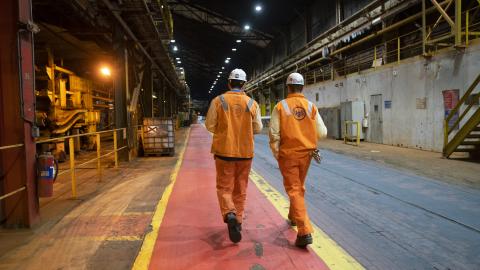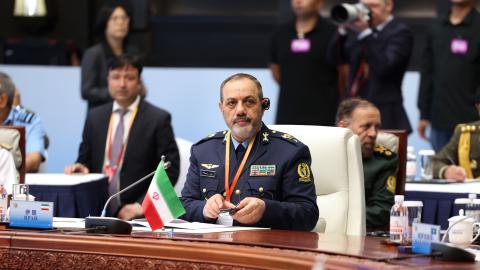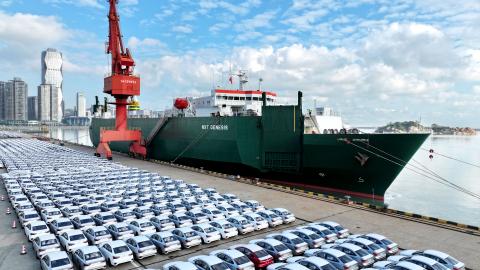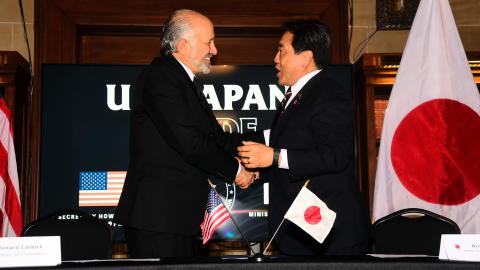The town of Parachinar, located in a far-flung corner of western Pakistan, is fondly called by some Iranian Shiites “Little Iran.” The majority of the town’s residents are ethnic Pashtuns who belong to the Shia faith. It is also the capital of Kurram Agency, one of the seven tribal districts that make up the politically volatile Federally Administrated Tribal Areas. In recent years, Parachinar has effectively been under siege by Sunni militants. Since 2007, waves of sectarian violence have killed hundreds of Shia from Parachinar. In reaction to this, Parachinar has become a potent symbol of Shia suffering, and the plight of its Shia residents has become a rallying cry for elements of the Iranian regime.
The tragic state of affairs in Parachinar may be seen as a reflection of the mounting sectarian strife which has threatened in recent years to engulf the Pakistani nation. It may also be used as a yardstick to measure the willingness and ability of the Islamic Republic of Iran to protect Shia communities wherever they might be. After all, the Tehran regime is often looked upon as the global champion and guardian of the Shia. And historically, the Islamic Republic has actively supported Shiite militancy internationally, including in Pakistan.
Today, however, Tehran’s actions rarely match its most fervent rhetoric about the suffering of Pakistan’s Shia. Indeed, among the ranks of Pakistan’s Shia activists, many today are disappointed by what they perceive as the lack of Iranian pressure on Islamabad to take measures to protect the Shia of Parachinar and to crackdown on sectarian groups and ideologies. In Iran as well, there are analysts and even senior Shia clergy who have condemned what they deem to be Tehran’s weak stance toward anti-Shia violence in Pakistan. As Shia-Sunni violence continues in Pakistan, Tehran’s position will invariably be scrutinized from different corners since Iran is an influential regional actor with the capacity to either fuel or rein in sectarian tensions and violence in Pakistan and elsewhere in Asia.
Parachinar as a Symbol
In early December 2011, Pakistani media reported that officials in Islamabad pledged a renewal in security operations against “non-local militants” in Parachinar. At a briefing at the National Assembly, government and intelligence officials informed lawmakers that some 1,100 people have been killed and hundreds of houses burnt in Parachinar since 2007. Meanwhile, the same government officials again promised to re-open the critical Thall-Parachinar road, a critical access point for the inhabitants of Parachinar whose town in effect came under siege with the road’s closure. Only time will show if the Pakistani government is genuinely committed to and able to come to the aid of the Shia of Kurram Agency. Needless to say, Pakistan’s Iranian critics are yet to be convinced.
In contrast to official Pakistani figures, Iran’s state-run English-language Press TV reported the number of dead in Parachinar to stand at “over 4,000.” Moreover, Iranian media have also implicated the Pakistani government in the violence, claiming officials have a policy of looking the other way and ignoring the plight of the Shia in Kurram Agency.1
As early as 2007, some of Iran’s state-run media began to describe Parachinar as a “Second Gaza” and lamented the situation of the “500,000 inhabitants under siege.”2 Grand Ayatollah Saafi Golpayegani, a prominent cleric in Iran’s holy city of Qom, became an early advocate of the Shia of Parachinar. In late 2007, Golpayegani famously told his congregation that in Parachinar they “cut heads and limbs off the Shia and no one utters a word.” Without mentioning the Iranian regime explicitly, the ayatollah criticized Tehran’s official silence and inaction following the siege of Parachinar. Iranians, Golpayegani said, “do not do as we should [in helping the Pakistani Shia] and we will have to answer to God.”3
The silence of Iran’s officialdom with respect to the plight of Pakistan’s Shia is conspicuous and openly criticized by the wider Iranian public. However, those who do criticize the Iranian government’s inaction, such as Ayatollah Golpayegani, are only loosely tied to the clerical regime. Meanwhile, a review of two key government websites--the official site of Ayatollah Ali Khamenei, Iran’s supreme leader, and the Islamic Republic News Agency, the outlet of President Mahmoud Ahmadinejad’s government--reveals almost no statements by Iranian political leaders about the situation of the Shia in Pakistan and the siege of Parachinar.4
In fact, both of these sites, along with many other state-controlled outlets in the Islamic Republic, mostly praise the current state of relations between Iran and Pakistan. In other words, those in charge of the Islamic Republic engage in a clear attempt to paint relations as healthy and to brush aside any factors that might complicate ties. Turning the case of Parachinar into a high-profile issue would undoubtedly agitate Tehran-Islamabad relations, not a scenario Iran would welcome given that it is already under a high degree of isolation on the regional and international stages.
Iran’s silence about the situation in Parachinar is seen as peculiar by many observers in Tehran. In a damning assessment in December 2011, one semi-official outlet asked how the Foreign Ministry in Tehran could do nothing as the world witnessed the “continuation of the killing of a generation of Shia [in Parachinar]?”5 The assessment included the appraisal of Javad Mansouri, the former Iranian ambassador to Pakistan, who stated that unsuccessful attempts had been made to “come to the economic aid of the people of Parachinar,” but that even in this more limited task the “[Iranian] authorities in Tehran did not comprehend the needs of [Shia in Parachinar] and did not cooperate [with Iran’s diplomats in Pakistan].”6
The role of the Islamic Republic and Tehran’s perception of Parachinar was quite different only a decade ago. In an interview with this author, Ali Akbar Omid-Mehr, a former senior Iranian diplomat to Pakistan, described Iran’s earliest hopes for Parachinar as a “springboard” for Iranian influence into broader Pakistan. Omid-Mehr, who defected from the Iranian regime in the mid-1990s, pointed out that in 1986 Iran’s then-Supreme Leader Grand Ayatollah Ruhollah Khomeini had specifically issued a fatwa with instructions that the Shia of Pakistan needed to be helped by the Iranian state.7 In retrospect, this period from the early 1980s until the mid-1990s can be said to have been the zenith of the Islamic Republic’s championing of Shia militancy in Pakistan. As such, present-day accusations about Iran’s purported complacency follow a period when Tehran was verifiably engaged in supporting Pakistani Shia groups.
Ayatollah Khomeini’s chief clerical representative in Pakistan from 1985, Syed Arif Hussain Al-Hussaini, was himself a native of the Parachinar region. In his assessment of sectarianism in Pakistan, Hassan Abbas points out that Al-Hussaini first met Khomeini when in exile in Najaf, Iraq in the 1970s and later followed him to Iran where he continued his religious studies in Qom.8 Abbas argues that Al-Hussaini represented a new crop of Pakistani Shia political activists who abandoned the traditionalist practices of the Shia community and embraced the revolutionary rhetoric of the Islamic Republic that came to power in 1979.9
Prior to his assassination by Sunni militants in 1988, Al-Hussaini openly spoke in Pakistan of the theocratic political system put in place in Iran by Khomeini and his followers serving as a “working model” for his Shia organization.10 As Maleeha Lodhi pointed out at the time, Al-Hussaini had a “militant political approach” to his activism, which at the time “brought him greater influence among a more assertive new generation of Shias [in Pakistan].”11 It is, however, important to note that the militancy that Al-Hussaini embraced, and which resonated so well with segments of the Shia activists in Pakistan, occurred at a time of great sectarian tensions in the country.
Since coming to power in 1977, General Zia ul-Haq sought to Islamicize his country. However, many of Pakistan’s Shia political elite viewed Islamabad’s new policies as sectarian, and tantamount to “Sunnification” of Pakistan at the expense of the religious minorities. Al-Hussaini was cautious in choosing his words, but his anxieties about Sunni supremacy in Pakistan were crystal clear. Proclaiming “Let the Sunnis as well as the Shiites live in Pakistan, let the Ahle Hadith and Deobandi, all of them, live together,” he then mentioned the broken promises of the Zia government which Al-Hussaini accused of opportunism and stirring religious discrimination in the country at the time.12
In other words, it was arguably not merely the 1979 Iranian revolution that reenergized the Pakistani Shia, but that the regime change in Tehran in 1979 had come at an opportune moment when a Sunni resurgence in Pakistan compelled some Shia activists to look for external patrons.13 The Shia theocratic regime in Tehran certainly fit the role of a benefactor but, as Abbas aptly points out, even then there were major splits in the ranks of the Pakistani Shia activists about the impact of Iranian patronage.14 Such dilemmas about Iranian sponsorship still impact the thinking of Shia activists, and not just in Pakistan but also in places such as Iraq, Lebanon and Bahrain.
In the end, Parachinar never became an effective springboard for Iranian ideological expansion into the rest of Pakistan, but Iran left its marks there. It opened up a cultural center (khaney-e farhang) in the town15 and, as Omid-Mehr explained, quickly helped the local Shia with materiel when some of the anti-Soviet Sunni mujahedeen based in Kurram Agency began to adopt a sectarian agenda.16 But not even the sum of such activities can amount to the description of Parachinar as a strategic conduit to the larger Pakistani Shia community.
In the meantime, from the mid-1990s, Iran’s revolutionary zeal temporarily subsided. Tehran began a policy of détente toward its neighbors under Presidents Ali Akbar Hashemi Rafsanjani and Mohammad Khatami. The exception was Afghanistan, a country in the midst of civil war where Iran had sided with Northern Afghan factions engaging in a fierce power struggle against Pakistani-backed Sunni Pashtun mujahedeen who subsequently coalesced under the Taliban banner. This de facto proxy war between Iran and Pakistan on Afghan soil was arguably one of the main reasons behind Tehran’s decision to cease its until-then patent support of Pakistani Shia organizations. Accordingly, Iran did not see itself as prepared to wage a two-pronged battle against the Pakistani state, and also feared Islamabad’s retaliation.17
Khameneism in Pakistan
By most accounts, Iranian sponsorship of Shia militant groups in Pakistan declined after the mid-1990s. That does not, however, mean that Iran’s leaders chose to cut off ties with the Shiite political scene in Pakistan altogether. In fact, the Pakistani Shia today constitute one of the key target audiences for Ayatollah Ali Khamenei’s political and religious messages. This is largely because of the prominent role of religion in the activities of a number of Shia organizations. Insofar as Pakistani Shia Islamist movements have looked for religious leadership, they have often looked to clergy outside Pakistan’s borders, and especially to Iran. Furthermore, since 1979,Tehran’s financial patronage for a host of Shia religious bodies has also been an important factor in making Irana significant influence among Shia in Pakistan.
One of the most important players in this regard is the Imamia Students Organization Pakistan (ISO). The Shia activist group, founded in 1972, advertises itself as the “largest student organization in Pakistan” with a nationwide network of some 800 branches.18 ISO is very public and emphatic about the fact that it considers Iran’s Supreme Leader Ayatollah Khamenei as its spiritual guide. It sees its mission and role in Pakistan as no different from that of the Lebanese Hezbollah or Iran’s Islamist Basij militia force. As such, it sees itself as a regional outpost for the Islamic Republic, and as a vanguard defending the Khomeinist concept of velayat-e faqih, or the rule of the supreme jurisprudent.
In an interview in 2009, the then-ISO leader Syed Hassan Zaidi stated that the organization has a “supervisory council with 19 members” at the top of its institutional hierarchy and that the ISO leadership is directly linked to the office of Ayatollah Khamenei in Tehran. At the time, Zaidi suggested that ISO had a combined student membership of 18,000-20,000 male and 6,000 female members.19 Zaidi and his successor, Kumail Abbas, have both maintained that the ISO does not see Khamenei’s leadership as limited to Iran’s boundaries, and both consider the Iranian leader as the leader of all Muslims.20
Khamenei’s ties with the ISO do, in fact, run deep. In 1989, shortly after he became the Supreme Leader, Khamenei met a group of ISO activists in Tehran. In his speech, which was intended to outline his vision for the future, and which is still available on his personal site,21 Khamenei revealed a great deal about the agenda that still lies at the core of Khamenei’s worldview. He spoke of the need for unity in the ranks of the world’s Muslims. In particular, he blamed the “imperialists” (the West) for undermining Muslim unity. In 1989, Khamenei said that “Imperialism and corrupt rulers, in the old and new ages, divided the Muslims and separated the houses [branches of Islam] and made them [Muslims] suspicious of each other.” Fast-forward 23 years and the crux of Khamenei’s message to the Shia of Pakistan has effectively remained the same. The supreme leader urges Muslim unity while remaining deeply anti-American and anti-West, as well as hostile to the status quo powers in the Greater Middle East including Saudi Arabia and other pro-US Arab states. If one examines Iran’s overt religious outreach in Pakistan today, it appears that the bulk of the country’s financial largess is spent on propagating such goals. In other words, Iran clearly has political objectives in Pakistan, but the way it seeks to further its agenda is primarily via religious-based assistance.
For example, Khamenei’s official site displays requests by various Pakistani Shia bodies for Iranian funding for the construction of sites of worship.22 Khamenei clearly desires to claim leadership over Pakistani Shia but is reluctant to make his ambitions clear, as he surely anticipates an angry official Pakistani response.
Here, historical context is also imperative. It is well-known that Pakistani Shia have from days predating the Islamic Republic looked to the clerics of Qomfor religious leadership. However, since Khamenei came to power the Shia religious linkages between Iran and Pakistan have noticeably shifted away from the marjas (the clerical sources of emulation) of Qom. Now, the linkages appear focused on garnering Pakistani acceptance of the Khomeinist concept of the vilayat-e faqih. Meanwhile, this process has also included a great deal of lionizing of Khamenei when Iranian efforts target the Shia of Pakistan.
The reason for this is basically twofold. First, at the end of the Iran-Iraq war in 1988, Tehran’s hands were financially freed to propagate its ideals more vigorously internationally. Khamenei was selected as supreme leader soon after, in June 1989. Second, because Khamenei lacked religious qualifications and a spiritual following before he was selected as supreme leader, he opted to look beyond Iran’s borders to establish his name as a marja. Because of the large size of the Shia population in Pakistan (some 20 per cent of the country’s 173 million) and also because there are relatively few leading Shia religious figures in the country, it appears that Khamenei decided that Pakistan was fertile ground for his religious outreach.
The Iranian state has marketed Khamenei and the ideology of velayat-e faqih in Pakistan both internally and externally. In addition to providing funds for Shia religious causes in Pakistan,23 Tehran also sponsors Shia religious students from the country to pursue studies in Iran. There are no precise figures for how many Pakistanis attend Iranian seminaries, but their presence is prominent, especially when compared with other nationalities.
Among Qom’s myriad of religious institutions, one office frequently stands out as the Iranian regime’s primary arm for outreach. The Daftar-e Tabliqat-e Eslami-e Howzeh-e Elmiyeh-e Qom (The Office of Islamic Propagation at Seminaries of Qom) is a coordinating agency that promotes itself as a bridge between the collective bodies of the seminaries in Qom and the regime officialdom.24 Its mandate is primarily aimed at the domestic religious-political scene in Iran but it regularly engages in advancing Iranian interests and Islamic unity (on Iranian terms) internationally.
Pakistani religious students from the ISO feature strongly in the office’s international activities. The office, for example, has hosted ISO students and also provided Shia theological students with instruction in the latest Islamic thoughts and practices in Iran.25 Clearly, the Daftar-e Tabliqat-e Eslami is engaged in religious indoctrination, and the person and worldview of Ayatollah Khamenei lie at the heart of the office’s outreach efforts.26
Accordingly, many of Pakistan’s Shia religious figures have become highly vocal and partisan supporters of Khamenei. For example, Syed Jawad Naqvi, a prominent activist preacher and the head of a recently-launched Shia seminary in Pakistan, idealizes the theocracy in the Islamic Republic of Iran and calls himself a devoted follower of Khamenei. He has additionally published articles as well as a book denouncing Iran’s anti-clerical Green opposition movement.27 Not surprisingly, Naqvi’s seminary was reportedly established in part with financial support from the Iranian state.28
Not only do Pakistan’s pro-Iran Shia ulema come to Khamenei’s defense when he faces his internal Iranian detractors, but they give much publicity and credence to his vision and role as a pan-regional Islamic leader.29 In one of the most recent high-profile examples, the Pakistani Shia leader Syed Sajid Naqvi, leader of Tehrik-e-Jafaria Pakistan (TJP), attended the “First International Islamic Awakening Conference”in Tehran in September 2011. Sajid Naqvi was quoted as saying that Khamenei’s leadership is going to “transform” the region after the political upheaval and change in a number of Arab countries.30 Such lavish praise of Khamenei surpasses even the statements of Iranian officials.31 Thanks to Iranian funding, this veneration of Khamenei has also become strongly visible in cyberspace. Today, dozens of Pakistani Shia Islamist websites are in operation and they actively engage in propagating the Iranian regime’s messages and the teachings of Ayatollah Khamenei.32
Violence and Regional Rivalry
Clearly, Khamenei has both the desire and the financial resources at his disposal to cultivate his religious leadership and political influence among Pakistan’s Shia population. Still, the supreme leader’s appeal in Pakistan, and the appeal of Iran more generally, fundamentally depends on the political and security circumstances of Pakistan’s Shia and the changing needs of the country’s Shia population. Right now, Pakistan’s Shia can in large numbers turn to Iran for support and patronage. And they appear especially inclined to do so now, as anti-Shia violence at the hands of radical Sunni takfiri groups continues unabated. In 2011 alone, hundreds of Shias were killed in sectarian violence across Pakistan.
As a result, while the Islamic Republic of Iran is careful not to act overtly as an agitator of the Shia in Pakistan, it does seek to capitalize on Pakistani Shia grievances. For example, Khamenei’s public comments about Pakistani affairs are routinely peppered with condolences about Shia deaths at the hands of extremist Sunni groups such as Lashkar-e Jhangvi.32 Invariably, Khamenei’s statements make two central points: that Islamic sectarianism is essentially a foreign plot to divide the Muslim Nation, and that local authorities in Pakistan are either collaborators in such schemes or simply do not do enough to bring an end to violence among various Muslim sects.34 Insofar as Tehran has been able to influence Pakistani Shia groups, these groups continue to act as broadcastersof the Iranian regime’s ideas.
Khamenei’s pronouncements on Pakistani affairs and other official Iranian statements are carefully drafted not to offend the authorities in Islamabad, but they also clearly suggest that the Pakistani state is complicit in sustaining the sectarian violence.35 At times, members of the Pakistani security forces are bluntly charged with involvement in the killing of Shias, but Iranian state-run media and officials are careful not to be overly explicit when they point the finger in the direction of Pakistani state institutions.36
Iran’s outreach in Pakistan is partly based on its desire to confront what it deems to be Saudi encroachment and the further spread of anti-Shia activities of extremist Sunni groups inspired by Saudi Wahhabism. This Iranian-Saudi rivalry on Pakistani soil over influence is particularly palpable when Iranian information campaigns vividly lay the blame on Saudi ideology and policies for violence against Shias in Pakistan. Such messages, which are propagated via dozens of pro-Iran websites, essentially portray the violence against Shia as part of a Saudi-American master plan to weaken the Muslim Nation by fueling sectarianism in the ranks of Muslims.
Insofar as Tehran seeks to prevent diplomatic fallout with Pakistan, the Iranian narrative does not depict Islamabad as being directly involved in fomenting sectarianism. Instead, the public vilification is reserved entirely for Iran’s two archenemies--the United States and Saudi Arabia. Nonetheless, a closer survey of Iranian opinion shows Tehran’s deep suspicions of Pakistan, including fears that Islamabad may repeat its policies of the 1980s and 1990s and back extremist Sunni groups in pursuit of its geopolitical agenda. In the context of Iran-Pakistan relations, no other arena is more sensitive than Afghanistan, where Tehran and Islamabad already have a record of proxy conflict dating back to the era of Taliban-rule in that country.
Meanwhile, recent developments have been ominous. On December 6, 2011, a series of devastating attacks brought mayhem to the Afghan cities of Kabul, Mazar-i Sharif and Kandahar, killing 80 people in total. The targets of these attacks were Afghanistan’s Shia minority. Even by the bloody standards of violence in Afghanistan, the incidents were particularly gruesome. The Pakistani sectarian group Lashkar-e Jhangvi quickly claimed responsibility for the attacks.37 Lashkar-e Jhangvi is notoriously violent and anti-Shia with a stated aim of turning Pakistan into a Sunni-only state. It is listed by Pakistan as a terrorist group but suspicion remains that it continues to enjoy some support from and is a pawn in the hands of the Pakistani intelligence services. The attacks were clearly designed to fuel sectarian tensions among Afghanistan’s diverse religious and ethnic groups. In the aftermath, fears of sectarian violence in Afghanistan quickly and invariably put the limelight on Shia-majority Iran and Sunni-majority Pakistan, the two powerful regional states.38
Iran’s official state media sought to downplay the sectarian nature of the attacks. For example, Tehran proceeded to paint the Western media’s reaction to the killings as part of the broader agenda of fostering division among Muslims and justifying a Western military presence in Afghanistan by pointing to the continuation of deep insecurity in the country.39 Behind such headlines, however, Iranian assessments are generally far less conspiratorial. They focus instead on the Pakistani government’s historical record as a supporter of militant organizations such as Lashkar-e Jhangvi and Lashkar-e Taiba, and some speculate about whether Tehran will again find itself in a proxy conflict with Pakistan in Afghanistan.
By all accounts, a return to the Iran-Pakistan rivalry of the 1990s is hardly something which the Islamic Republic of Iran wants. This is above all due to the fact that Tehran is at the moment under unprecedented international isolation due to its nuclear program. Tehran would therefore have to be hard-pressed to choose to confront the Pakistani state, either in Afghanistan or by inciting Pakistan’s Shia population against the Islamabad government. In fact, the hope in Tehran is that Islamabad could instead look more favorably toward Iran as Pakistan-U.S. relations remain poor and Islamabad seeks to augment its list of allies.
For the foreseeable future, Tehran will likely stick with the same policies toward Pakistan’s Shia that have effectively been in place for the last decade. The Islamic Republic will continue to present itself as the ultimate champion of the Shia on the subcontinent, but it will do so carefully and in a targeted fashion aimed at maximizing ideological influence over ISO and other Pakistani Shia Islamist groups who subscribe to the principles of velayat-e faqih.
In the end,Tehrancan disguise the international pursuit of its political objectives as religious outreach, but Iran’s influence among Pakistan’s Shia should not be exaggerated. Iran’s clerical government and its religious practices are by no means acceptable or appealing to all the Shia of Pakistan. Moreover, because Tehran’s actions do not match the rhetoric of some elements in the Islamic Republic, Pakistan’s Shia are increasingly unlikely to view Iran as a reliable guardian or benefactor. Indeed, Tehran’s reaction to the siege of Parachinar is a good example of the political cautiousness of Iran’s clerical rulers, and of the fact that Iranian support for the Shia in Pakistan has become as much, if not more, a product of geopolitical calculation as it is of religious sympathy or Islamist ideology.
Despite this, Iran’s outreach to the Shia of Pakistan has historically fluctuated as a function of sectarian relations inside Pakistan and of Tehran’s overall relations with Islamabad. When sectarian tensions rise in Pakistan and Tehran-Islamabad relations are poor, Iran’s support for the Pakistani Shia has historically been at its strongest. In the early 1980s to the mid-1990s, for example, when sectarian tensions and violence expanded in Pakistan, the Iranian regime became a strident supporter of the Shia and of militant Shiism. Now, given the deteriorating state of Shia-Sunni relations in Pakistan, and also given the fact that Iran’s clerical establishment is under attack by “Shiite nationalists” at home, conditions may be ripe for Iran to take renewed interest in the plight of Pakistan’s Shia once again.
